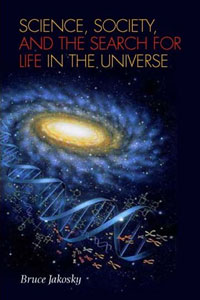|
|
Review: astrobiology and society
by Jeff Foust
Monday, November 13, 2006
Science, Society, and the Search for Life in the Universe
by Bruce Jakosky
Univ. of Arizona Press, 2006
softcover, 160 pp.,
ISBN 0-8165-2613-3
US$17.95
A fair amount has been written in recent years about the emerging science of astrobiology: the search for life, intelligent or otherwise, on other worlds in this and other solar systems. Far less, though, has been written about the interplay of astrobiology and the sciences that constitute this multidisciplinary field with broader society—a factor that could become critical should astrobiologists one day discover evidence of life beyond Earth. That, and many other far-reaching issues associated with astrobiology, are tackled by University of Colorado scientist Bruce Jakosky in Science, Society, and the Search for Life in the Universe.
While Jakosky performs astrobiological research, this book is less about the science of astrobiology than, as the title suggests, the intersection of that science with broader society. For such a slender volume (less than 150 pages excluding bibliography and index), he goes after some very big, meaty issues: the definition of life, the definition of science (and whether astrobiology can be considered a science), the interplay of astrobiology and other sciences with religion, and the communication (or lack thereof) between scientists and the general public. That’s a lot of ground to cover in a short book, but in general Jakosky does it effectively.
| Jakosky goes after some very big, meaty issues: the definition of life, the definition of science (and whether astrobiology can be considered a science), the interplay of astrobiology and other sciences with religion, and the communication (or lack thereof) between scientists and the general public. |
At times Jakosky appears to go off on tangents that are not directly relevant to astrobiology per se, such as a multipage rant on the “stamp collecting” approach to entry-level science courses in universities. He does, though, bring it together towards the end by revisiting C.P. Snow’s famous “two cultures”—scientists who are culturally illiterate and other intellectuals who are scientifically illiterate. Astrobiology has a chance to become a key science for the 21st century, he believes, but only if its practitioners can bridge the existing gap between the cultures and effectively communicate with the public. The end of the book includes a “call for action” with recommendations for scientists on how to do just that.
Science, Society, and the Search for Life in the Universe is not a book to read if you want to learn about the science of astrobiology itself: other recent books, such as Astrobiology: A Brief Introduction, cover that in much greater detail. (See “Review: Astrobiology: A Brief Introduction”, The Space Review, September 18, 2006.) Instead, this book looks at some of the broader issues that will determine how astrobiology is received by the general public, and in turn how willing the public will be to support continued research. Astrobiology, Jakosky believes, could be a key part of future space exploration efforts (although, ironically, NASA is cutting funding for astrobiology research, an issue not directly addressed in the book) if scientists are willing to engage with the public and explain their significance of their work. That same lesson may hold true for space exploration efforts in general.
Jeff Foust (jeff@thespacereview.com) is the editor and publisher of The Space Review. He also operates the Spacetoday.net web site and the Space Politics and Personal Spaceflight weblogs. Views and opinions expressed in this article are those of the author alone, and do not represent the official positions of any organization or company, including the Futron Corporation, the author’s employer.
|
|
